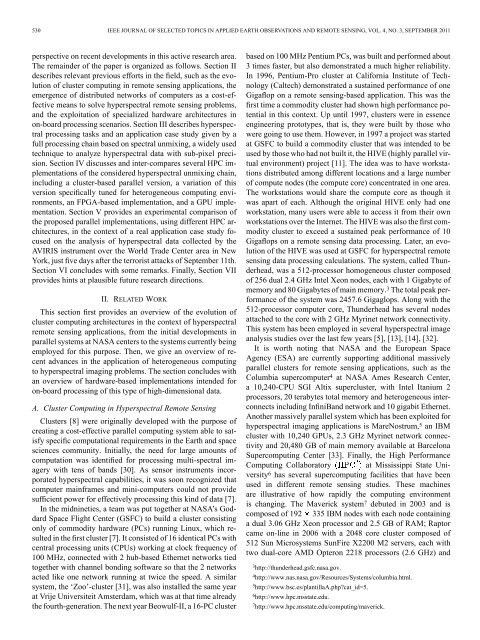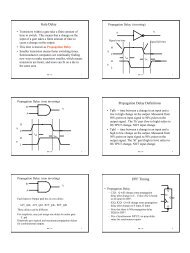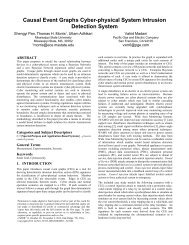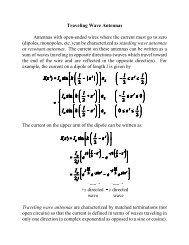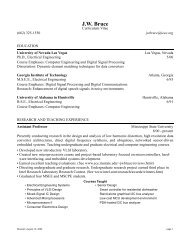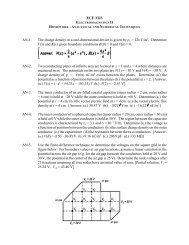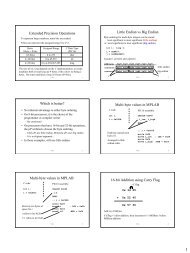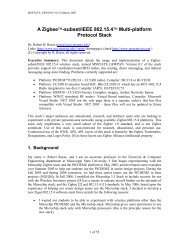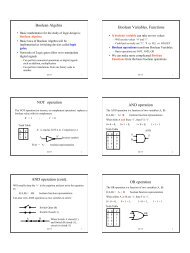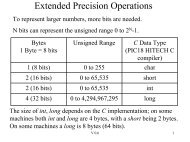High Performance Computing for Hyperspectral ... - IEEE Xplore
High Performance Computing for Hyperspectral ... - IEEE Xplore
High Performance Computing for Hyperspectral ... - IEEE Xplore
Create successful ePaper yourself
Turn your PDF publications into a flip-book with our unique Google optimized e-Paper software.
530 <strong>IEEE</strong> JOURNAL OF SELECTED TOPICS IN APPLIED EARTH OBSERVATIONS AND REMOTE SENSING, VOL. 4, NO. 3, SEPTEMBER 2011<br />
perspective on recent developments in this active research area.<br />
The remainder of the paper is organized as follows. Section II<br />
describes relevant previous ef<strong>for</strong>ts in the field, such as the evolution<br />
of cluster computing in remote sensing applications, the<br />
emergence of distributed networks of computers as a cost-effective<br />
means to solve hyperspectral remote sensing problems,<br />
and the exploitation of specialized hardware architectures in<br />
on-board processing scenarios. Section III describes hyperspectral<br />
processing tasks and an application case study given by a<br />
full processing chain based on spectral unmixing, a widely used<br />
technique to analyze hyperspectral data with sub-pixel precision.<br />
Section IV discusses and inter-compares several HPC implementations<br />
of the considered hyperspectral unmixing chain,<br />
including a cluster-based parallel version, a variation of this<br />
version specifically tuned <strong>for</strong> heterogeneous computing environments,<br />
an FPGA-based implementation, and a GPU implementation.<br />
Section V provides an experimental comparison of<br />
the proposed parallel implementations, using different HPC architectures,<br />
in the context of a real application case study focused<br />
on the analysis of hyperspectral data collected by the<br />
AVIRIS instrument over the World Trade Center area in New<br />
York, just five days after the terrorist attacks of September 11th.<br />
Section VI concludes with some remarks. Finally, Section VII<br />
provides hints at plausible future research directions.<br />
II. RELATED WORK<br />
This section first provides an overview of the evolution of<br />
cluster computing architectures in the context of hyperspectral<br />
remote sensing applications, from the initial developments in<br />
parallel systems at NASA centers to the systems currently being<br />
employed <strong>for</strong> this purpose. Then, we give an overview of recent<br />
advances in the application of heterogeneous computing<br />
to hyperspectral imaging problems. The section concludes with<br />
an overview of hardware-based implementations intended <strong>for</strong><br />
on-board processing of this type of high-dimensional data.<br />
A. Cluster <strong>Computing</strong> in <strong>Hyperspectral</strong> Remote Sensing<br />
Clusters [8] were originally developed with the purpose of<br />
creating a cost-effective parallel computing system able to satisfy<br />
specific computational requirements in the Earth and space<br />
sciences community. Initially, the need <strong>for</strong> large amounts of<br />
computation was identified <strong>for</strong> processing multi-spectral imagery<br />
with tens of bands [30]. As sensor instruments incorporated<br />
hyperspectral capabilities, it was soon recognized that<br />
computer mainframes and mini-computers could not provide<br />
sufficient power <strong>for</strong> effectively processing this kind of data [7].<br />
In the midnineties, a team was put together at NASA’s Goddard<br />
Space Flight Center (GSFC) to build a cluster consisting<br />
only of commodity hardware (PCs) running Linux, which resulted<br />
in the first cluster [7]. It consisted of 16 identical PCs with<br />
central processing units (CPUs) working at clock frequency of<br />
100 MHz, connected with 2 hub-based Ethernet networks tied<br />
together with channel bonding software so that the 2 networks<br />
acted like one network running at twice the speed. A similar<br />
system, the ‘Zoo’-cluster [31], was also installed the same year<br />
at Vrije Universiteit Amsterdam, which was at that time already<br />
the fourth-generation. The next year Beowulf-II, a 16-PC cluster<br />
based on 100 MHz Pentium PCs, was built and per<strong>for</strong>med about<br />
3 times faster, but also demonstrated a much higher reliability.<br />
In 1996, Pentium-Pro cluster at Cali<strong>for</strong>nia Institute of Technology<br />
(Caltech) demonstrated a sustained per<strong>for</strong>mance of one<br />
Gigaflop on a remote sensing-based application. This was the<br />
first time a commodity cluster had shown high per<strong>for</strong>mance potential<br />
in this context. Up until 1997, clusters were in essence<br />
engineering prototypes, that is, they were built by those who<br />
were going to use them. However, in 1997 a project was started<br />
at GSFC to build a commodity cluster that was intended to be<br />
used by those who had not built it, the HIVE (highly parallel virtual<br />
environment) project [11]. The idea was to have workstations<br />
distributed among different locations and a large number<br />
of compute nodes (the compute core) concentrated in one area.<br />
The workstations would share the compute core as though it<br />
was apart of each. Although the original HIVE only had one<br />
workstation, many users were able to access it from their own<br />
workstations over the Internet. The HIVE was also the first commodity<br />
cluster to exceed a sustained peak per<strong>for</strong>mance of 10<br />
Gigaflops on a remote sensing data processing. Later, an evolution<br />
of the HIVE was used at GSFC <strong>for</strong> hyperspectral remote<br />
sensing data processing calculations. The system, called Thunderhead,<br />
was a 512-processor homogeneous cluster composed<br />
of 256 dual 2.4 GHz Intel Xeon nodes, each with 1 Gigabyte of<br />
memory and 80 Gigabytes of main memory. 3 The total peak per<strong>for</strong>mance<br />
of the system was 2457.6 Gigaglops. Along with the<br />
512-processor computer core, Thunderhead has several nodes<br />
attached to the core with 2 GHz Myrinet network connectivity.<br />
This system has been employed in several hyperspectral image<br />
analysis studies over the last few years [5], [13], [14], [32].<br />
It is worth noting that NASA and the European Space<br />
Agency (ESA) are currently supporting additional massively<br />
parallel clusters <strong>for</strong> remote sensing applications, such as the<br />
Columbia supercomputer 4 at NASA Ames Research Center,<br />
a 10,240-CPU SGI Altix supercluster, with Intel Itanium 2<br />
processors, 20 terabytes total memory and heterogeneous interconnects<br />
including InfiniBand network and 10 gigabit Ethernet.<br />
Another massively parallel system which has been exploited <strong>for</strong><br />
hyperspectral imaging applications is MareNostrum, 5 an IBM<br />
cluster with 10,240 GPUs, 2.3 GHz Myrinet network connectivity<br />
and 20,480 GB of main memory available at Barcelona<br />
Supercomputing Center [33]. Finally, the <strong>High</strong> <strong>Per<strong>for</strong>mance</strong><br />
<strong>Computing</strong> Collaboratory at Mississippi State University<br />
6 has several supercomputing facilities that have been<br />
used in different remote sensing studies. These machines<br />
are illustrative of how rapidly the computing environment<br />
is changing. The Maverick system 7 debutedin2003andis<br />
composed of 192 335 IBM nodes with each node containing<br />
a dual 3.06 GHz Xeon processor and 2.5 GB of RAM; Raptor<br />
came on-line in 2006 with a 2048 core cluster composed of<br />
512 Sun Microsystems SunFire X2200 M2 servers, each with<br />
two dual-core AMD Opteron 2218 processors (2.6 GHz) and<br />
3 http://thunderhead.gsfc.nasa.gov.<br />
4 http://www.nas.nasa.gov/Resources/Systems/columbia.html.<br />
5 http://www.bsc.es/plantillaA.phpcat_id=5.<br />
6 http://www.hpc.msstate.edu.<br />
7 http://www.hpc.msstate.edu/computing/maverick.


